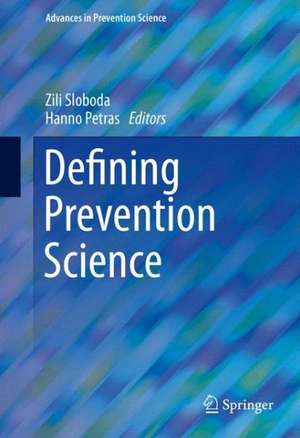Defining Prevention Science: Advances in Prevention Science
Editat de Zili Sloboda, Hanno Petrasen Limba Engleză Hardback – 28 feb 2014
Defining Prevention Science covers this emerging field of science: its goals, its conceptual and theoretical foundations, its methods and especially its utility. Not content to simply differentiate the field from its close allies: epidemiology, psychology, neuroscience, sociology, economics, the text explains how these many disciplines enhance each other at both research and intervention levels and how prevention science draws on these biological, behavioral and social sciences to create an innovative knowledge base that has provided cost-effective, evidence-based prevention interventions and policies. To this end, familiar developmental benchmarks are recast in prevention/health promotion context, from the crucial importance of adolescence in encountering and deterring high-risk behaviors to the risks and resiliencies of single-mother families. An international group of contributors offers current findings, up-to-date methods for effective evidence-based interventions and improvements in research technologies in these key areas:
- Physical, cognitive and emotional vulnerability across the life course.
- The roles of developmental influences in prevention.
- Intervention development, delivery and implementation.
- Bringing the intervention approach to research design.
- New directions in analytic methods.
- Cost analysis and policy implications.
| Toate formatele și edițiile | Preț | Express |
|---|---|---|
| Paperback (1) | 798.19 lei 6-8 săpt. | |
| Springer Us – 3 sep 2016 | 798.19 lei 6-8 săpt. | |
| Hardback (1) | 742.44 lei 6-8 săpt. | |
| Springer Us – 28 feb 2014 | 742.44 lei 6-8 săpt. |
Preț: 742.44 lei
Preț vechi: 781.52 lei
-5% Nou
Puncte Express: 1114
Preț estimativ în valută:
142.11€ • 154.42$ • 119.45£
142.11€ • 154.42$ • 119.45£
Carte tipărită la comandă
Livrare economică 21 aprilie-05 mai
Preluare comenzi: 021 569.72.76
Specificații
ISBN-13: 9781489974235
ISBN-10: 1489974237
Pagini: 648
Ilustrații: XXII, 626 p. 39 illus.
Dimensiuni: 155 x 235 x 43 mm
Greutate: 1.08 kg
Ediția:2014
Editura: Springer Us
Colecția Springer
Seria Advances in Prevention Science
Locul publicării:New York, NY, United States
ISBN-10: 1489974237
Pagini: 648
Ilustrații: XXII, 626 p. 39 illus.
Dimensiuni: 155 x 235 x 43 mm
Greutate: 1.08 kg
Ediția:2014
Editura: Springer Us
Colecția Springer
Seria Advances in Prevention Science
Locul publicării:New York, NY, United States
Public țintă
ResearchCuprins
Prevention Science: An Epidemiological Approach Individual Physical, Cognitive, and Emotional Vulnerability across the Life Course: Benchmarks and Developmental Challenges.- Pre-natal and Infancy.- Childhood and the Entry into Adolescence: A Pivotal Period in Health-Related Behaviors and Prevention.- Adolescent and Early Adulthood.- Stressors and Vulnerabilities in Middle and Old Age: Opportunities for Prevention.- Environmental Influences.- Family.- School Influences on Child and Youth Development.- Peer Networks.- Risk and Resilience Processes in Single Mother Families: An Interactionist Perspective.- Environmental Influences: the workplace and mental health: models, vulnerability factors and interventions.- An Integrated Prevention Science Model - A Conceptual Foundation for Prevention Research.-Design of Preventive Interventions.- Implementation Science and the Effective Delivery of Evidence-Based Prevention.- Factors Impacting Implementation: Training and Cultural Adaptation.- Measuring Fidelity.- Research Design.- Translating the Intervention Approach into an Appropriate Research Design –The Next Generation Designs for Effectiveness and Implementation Research.- The Epidemiologic Case-Crossover and Case-Control Approaches in Prevention Research.- The Use of Simulation Models in Public Health with Applications to Substance Abuse and Obesity Problems.- Meta-analysis in Prevention Science.- Mixed Methods Research Design for Prevention Science Methods, Critiques, and Recommendations.- Analytic Methods.- Latent Class Analysis in Prevention Science.- Discrete-time Survival Analysis in Prevention Science.- Using Mediation and Moderation Analyses to Enhance Prevention Research.- Analytic Methods: Advances in Missing Data Models and Fidelity Issues of Implementing these Methods in Prevention Science.- Cost Analysis and Policy.- Economic Analysis and Policy Studies: Special Challenges in the Prevention Sciences.- Strengthening prevention science to ensureeffectiveness of intervention in practice: setting up an international agenda.
Textul de pe ultima copertă
Whoever coined the adage "an ounce of prevention is worth a pound of cure" could not have known how important this adage would become. The challenge of altering the health trajectories of poor lifestyle decisions for such behaviors as smoking, drinking, and using illicit drugs, violence, dropping out of school, engagement in risky sexual behaviors, and crime through prevention research has led to a new discipline, prevention science.
Defining Prevention Science covers this emerging field of science: its goals,its conceptual and theoretical foundations, its methods, and especially its utility. Not content to simply differentiate the field from its close allies: epidemiology, psychology, neuroscience, sociology, economics, the text explains how these many disciplines enhance each other at both research and intervention levels, and how prevention science draws on these biological, behavioral, and social sciences to create an innovative knowledge base that has provided cost-effective, evidence-based prevention interventions and policies. To this end, familiar developmental benchmarks are recast in prevention/health promotion context, from the crucial importance of adolescence in encountering and deterring high-risk behaviors to the risks and resiliencies of single-mother families. An international group of contributors offers current findings, up-to-date methods for effective evidence-based interventions, and improvements in research technologies in these key areas:
Defining Prevention Science covers this emerging field of science: its goals,its conceptual and theoretical foundations, its methods, and especially its utility. Not content to simply differentiate the field from its close allies: epidemiology, psychology, neuroscience, sociology, economics, the text explains how these many disciplines enhance each other at both research and intervention levels, and how prevention science draws on these biological, behavioral, and social sciences to create an innovative knowledge base that has provided cost-effective, evidence-based prevention interventions and policies. To this end, familiar developmental benchmarks are recast in prevention/health promotion context, from the crucial importance of adolescence in encountering and deterring high-risk behaviors to the risks and resiliencies of single-mother families. An international group of contributors offers current findings, up-to-date methods for effective evidence-based interventions, and improvements in research technologies in these key areas:
- Physical, cognitive, and emotional vulnerability across the life course.
- The roles of developmental influences in prevention.
- Intervention development, delivery, and implementation.
- Bringing the intervention approach to research design.
- New directions in analytic methods.
- Cost analysis and policy implications.
Caracteristici
First volume in the new series, Advances in Prevention Science Extensive coverage of epidemiological and statistical methods used in prevention research Brings together experts in the design and analysis of intervention trials Includes supplementary material: sn.pub/extras












